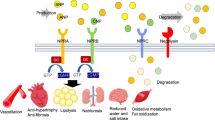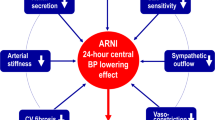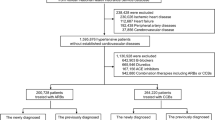Abstract
Effective treatment of hypertension is essential to reduce the risk of renal and cardiovascular (CV) morbidity. The risks associated with hypertension are modulated by the presence of other factors. This has prompted the quest for agents that have benefits beyond blood pressure (BP) lowering. The angiotensin II receptor blocker (ARB) class of antihypertensive agents represents an important addition to the therapeutic options for elevated BP. Their ability to control BP is equivalent to existing therapies and there is a considerable and mounting evidence-base for their ability to reduce hypertension-associated target organ damage and comorbidities. Studies show that ARBs have clinical benefits across the spectrum of disease severity. In particular, recent large studies have demonstrated that these benefits extend to patients with conditions predisposing to CV events, such as diabetes, left ventricular hypertrophy and microalbuminuria, and where risk factors coexist. Data from these studies suggest that the CV protective effects of ARBs are at least, in part, independent from the BP lowering action. In addition, ARBs are extremely well tolerated, and strong evidence suggests that compliance with therapy — a key factor in achieving adequate BP control — with ARBs is higher than with other antihypertensive agents. Furthermore, flexible dosing and good tolerability profile mean that, where necessary, ARBs can be combined with other classes of antihypertensive agents to achieve adequate BP control and reduce the risk of hypertension-associated morbidity.
This is a preview of subscription content, access via your institution
Access options
Subscribe to this journal
Receive 12 digital issues and online access to articles
$119.00 per year
only $9.92 per issue
Buy this article
- Purchase on Springer Link
- Instant access to full article PDF
Prices may be subject to local taxes which are calculated during checkout




Similar content being viewed by others
References
Lewington S et al. Age-specific relevance of usual blood pressure to vascular mortality: a meta-analysis of individual data for one million adults in 61 prospective studies. Lancet 2002; 360: 1903–1913.
Isles CG et al. Mortality in patients of the Glasgow Blood Pressure Clinic. J Hypertens 1986; 4: 141–156.
Hansson L et al for the HOT Study Group. Effects of intensive blood-pressure lowering and low-dose aspirin in patients with hypertension: principal results of the Hypertension Optimal Treatment (HOT) randomised trial. Lancet 1998; 351: 1755–1762.
Andersson OK et al. Survival in treated hypertension: follow up study after two decades. Br Med J 1998; 317: 167–171.
Blood Pressure Lowering Treatment Trialists' Collaboration. Effect of angiotensin-converting enzyme inhibitors, calcium antagonists, and other blood pressure lowering drugs: results of prospectively designed overviews of randomized trials. Lancet 2000; 355: 1955–1964.
Yusuf S et al for the Hearth Outcomes Prevention Evaluation (HOPE) Study Group. Effects of angiotensin-converting enzyme inhibitor, ramipril, on cardiovascular events in high-risk patients. New Engl J Med 2000; 342: 145–153.
PROGRESS Collaborative Group. Randomized trial of perindopril-based blood-pressure-lowering regimen among 6105 individuals with previous stroke or transient ischaemic attack. Lancet 2001; 358: 1033–1041.
Dahlof B et al for the LIFE Study Group. Cardiovascular morbidity and mortality in the Losartan Intervention For End-point reduction in hypertension study (LIFE): a randomised trial against atenolol. Lancet 2002; 359: 995–1003.
Lewis EJ et al for the IDNT Collaborative Study Group. Renoprotective effect of the angiotensin-receptor antagonist irbesartan in patients with nephropathy due to type 2 diabetes. N Engl J Med 2001; 345(12): 851–860.
Brenner BM et al for the RENAAL Study Investigators. Effects of losartan on renal and cardiovascular outcomes in patients with type 2 diabetes and nephropathy. N Engl J Med 2001; 345(12): 861–869.
Ruilope LM, Coca A, Volpe M, Waeber B . ACE inhibition and cardiovascular mortality and morbidity in essential hypertension: the end of the search or a need for further investigations? Am J Hypertens 2002; 15: 367–371.
Alderman MH et al. Association of the renin-sodium profile with the risk of myocardial infarction in patients with hypertension. N Engl J Med 1991; 324(16): 1098–1104.
Chobanian A et al. The Seventh Report of the Joint National Committee on Prevention, Detection, Evaluation, and Treatment of High Blood Pressure: The JNC 7 Report. JAMA 2003; 289: 2560–2571.
European Society of Hypertension–European Society of Cardiology Guidelines Committee. 2003 European Society of Hypertension–European Society of Cardiology guidelines for the management of arterial hypertension. J Hypertension 2003; 21: 1011–1053.
Burt VL et al. Trends in the prevalence, awareness, treatment, and control of hypertension in the adult US population. Data from the health examination surveys, 1960 to 1991. Hypertension 1995; 26: 60–69.
Primatesta P, Brookes M, Poulter NR . Improved hypertension management and control: results from the health survey for England 1998. Hypertension 2001; 38: 827–832.
Volpe M et al. Beyond hypertension: towards guidelines for cardiovascular risk reduction. Am J Hypertens 2004; 17(11 Part 1): 1068–1074.
Lip GY, Beevers DG . More evidence on blocking the renin–angiotensin–aldosterone system in cardiovascular disease and the long-term treatment of hypertension: data from recent clinical trials (CHARM, EUROPA, Val-HeFT, HOPE and SYST-EUR). J Hum Hypertens 2003; 17: 747–750.
Timmermans PB . Pharmacological properties of angiotensin II receptor antagonists. Can J Cardiol 1999; 15(Suppl F): 26F–28F.
Bloom BS . Continuation of initial antihypertensive medication after 1 year of therapy. Clin Ther 1998; 20: 671–681.
Moriwaki H et al. Losartan, an angiotensin II (AT1) receptor antagonist, preserves cerebral blood flow in hypertensive patients with a history of stroke. J Hum Hypertens 2004; 18(10): 693–699.
Julius S et al for the VALUE trial group. Outcomes in hypertensive patients at high cardiovascular risk treated with regimens based on valsartan or amlodipine: the VALUE randomised trial. Lancet 2004; 363(9426): 2022–2031.
Benz JR et al. Valsartan and hydrochlorothiazide in patients with essential hypertension. A multiple dose, double-blind, placebo controlled trial comparing combination therapy with monotherapy. J Hum Hypertens 1998; 12(12): 861–866.
Mallion JM et al. Valsartan, a new angiotensin II antagonist; blood pressure reduction in essential hypertension compared with an angiotensin converting enzyme inhibitor, enalapril. Blood Press Monit 1997; 2(4): 179–184.
Parving HH et al for the Irbesartan in Patients with type 2 Diabetes Microalbuminuria (IRMA2) Study Group. The effect of irbesartan on the development of diabetic nephropathy in patients with type 2 diabetes. N Engl J Med 2001; 345: 870–878.
Alderman MH et al. Association of the renin-sodium profile with the risk of myocardial infarction in patients with hypertension. N Engl J Med 1991; 324: 1098–1104.
Burnier M, Brunner HR . Angiotensin II receptor antagonists. Lancet 2000; 355: 637–645.
Volpe M et al. Angiotensin II AT2 receptor subtype: an uprising frontier in cardiovascular disease? J Hypertens 2003; 21: 1429–1443.
Kjeldsen SE et al LIFE (Losartan Intervention for Endpoint Reduction) Study Group. Effects of losartan on cardiovascular morbidity and mortality in patients with isolated systolic hypertension and left ventricular hypertrophy: a Losartan Intervention for Endpoint Reduction (LIFE) substudy. JAMA 2002; 288(12): 1491–1498.
Lindholm LH et al for the LIFE study group. Effect of losartan on sudden cardiac death in people with diabetes: data from the LIFE study. Lancet 2003; 362(9384): 619–620.
Weber MA et al. Blood pressure dependent and independent effects of antihypertensive treatment on clinical events in the VALUE Trial. Lancet 2004; 363(9426): 2049–2051.
Julius S et al VALUE Trial. VALUE trial: long-term blood pressure trends in 13,449 patients with hypertension and high cardiovascular risk. Am J Hypertens 2003; 16(7): 544–548.
ALLHAT Officers Coordinators for the ALLHAT Collaborative Research Group. The Antihypertensive and Lipid-Lowering Treatment to Prevent Heart Attack Trial. Major outcomes in high-risk hypertensive patients randomized to angiotensin-converting enzyme inhibitor or calcium channel blocker vs diuretic: The Antihypertensive and Lipid-Lowering Treatment to Prevent Heart Attack Trial (ALLHAT). JAMA 2002; 288: 2981–2997.
Hansson L et al. Effect of angiotensin-converting-enzyme inhibition compared with conventional therapy on cardiovascular morbidity and mortality in hypertension: the Captopril Prevention Project (CAPPP) randomised trial. Lancet 1999; 353: 611–616.
Alderman MH, Cohen HW, Sealey JE, Laragh JH . Plasma renin activity levels in hypertensive persons: their wide range and lack of suppression in diabetic and in most elderly patients. Am J Hypertens 2004; 17(1): 1–7.
Verdecchia P et al. Adverse prognostic significance of new diabetes in treated hypertensive subjects. Hypertension 2004; 43(5): 963–969.
Sharma AM et al. Angiotensin blockade prevents type 2 diabetes by formation of fat cells. Hypertension 2002; 40(5): 609–611.
Sowers JR . Insulin resistance and hypertension. Am J Physiol Heart Circ Physiol 2004; 286(5): H1597–H1602.
Viberti G et al for the MicroAlbuminuria Reduction With VALsartan (MARVAL) Study Investigators. Microalbuminuria reduction with valsartan in patients with type 2 diabetes mellitus. A blood pressure-independent effect. Circulation 2002; 106: 672–678.
Ibsen H et al. Does albuminuria predict cardiovascular outcome on treatment with losartan versus atenolol in hypertension with left ventricular hypertrophy? A LIFE substudy. J Hypertens 2004; 22(9): 1805–1811.
Cohn JN et al for the Valsartan Heart Failure Trial Investigators. A randomized trial of the Angiotensin II Receptor Blocker Valsartan in Congestive Heart Failure (Val-HeFT). N Engl J Med 2001; 345: 1667–1675.
Granger CB et al for the CHARM Investigators and Committees. Effects of candesartan in patients with chronic heart failure and reduced left ventricular systolic function intolerant to angiotensin-converting-enzyme inhibitors: the CHARM-alternative trial. Lancet 2003; 362: 772–776.
McMurray JJ et al for the CHARM Investigators and Committees. Effects of candesartan in patients with chronic heart failure and reduced left ventricular systolic function taking angiotensin-converting-enzyme inhibitors: the CHARM-Added trial. Lancet 2003; 362: 767–771.
Yusuf S et al for the CHARM Investigators and Committees. CHARM-Preserved Effects of candesartan in patients with chronic heart failure and preserved left-ventricular ejection fraction: the CHARM-Preserved Trial. Lancet 2003; 362(9386): 777–781.
Pfeffer MA et al. Effects of candesartan on mortality and morbidity in patients with chronic heart failure: the CHARM-Overall Programme. Lancet 2003; 362: 759–766.
Pfeffer MA et al for the Valsartan in Acute Myocardial Infarction Trial Investigators (VALIANT). Valsartan, captopril, or both in myocardial infarction complicated by heart failure, left ventricular dysfunction, or both. N Engl J Med 2003; 349: 1893–1906.
Weber MA et al. Quality of life measured in a practice-based hypertension trial of an angiotensin receptor blocker. J Clin Hypertens (Greenwich) 2003; 5: 322–329.
Acknowledgements
We thank Giuliano Tocci MD for help and assistance in preparing the manuscript.
Author information
Authors and Affiliations
Corresponding author
Appendix
Appendix
Potential Conflict of Interest
All authors have given lectures for industries producing ARBs.
Rights and permissions
About this article
Cite this article
Volpe, M., Ruilope, L., McInnes, G. et al. Angiotensin-II receptor blockers: benefits beyond blood pressure reduction?. J Hum Hypertens 19, 331–339 (2005). https://doi.org/10.1038/sj.jhh.1001831
Received:
Revised:
Accepted:
Published:
Issue Date:
DOI: https://doi.org/10.1038/sj.jhh.1001831
Keywords
This article is cited by
-
ARB-Based Combination Therapy for the Clinical Management of Hypertension and Hypertension-Related Comorbidities: A Spotlight on Their Use in COVID-19 Patients
High Blood Pressure & Cardiovascular Prevention (2021)
-
Effects of dual inhibition of renin–angiotensin–aldosterone system on cardiovascular and renal outcomes: balancing the risks and the benefits
Internal and Emergency Medicine (2020)
-
Automated Office Blood Pressure is Associated with Urine Albumin Excretion in Hypertensive Subjects
American Journal of Hypertension (2012)
-
Comparing angiotensin II receptor blockers on benefits beyond blood pressure
Advances in Therapy (2010)
-
Renal resistive index and cardiovascular organ damage in a large population of hypertensive patients
Journal of Human Hypertension (2007)



